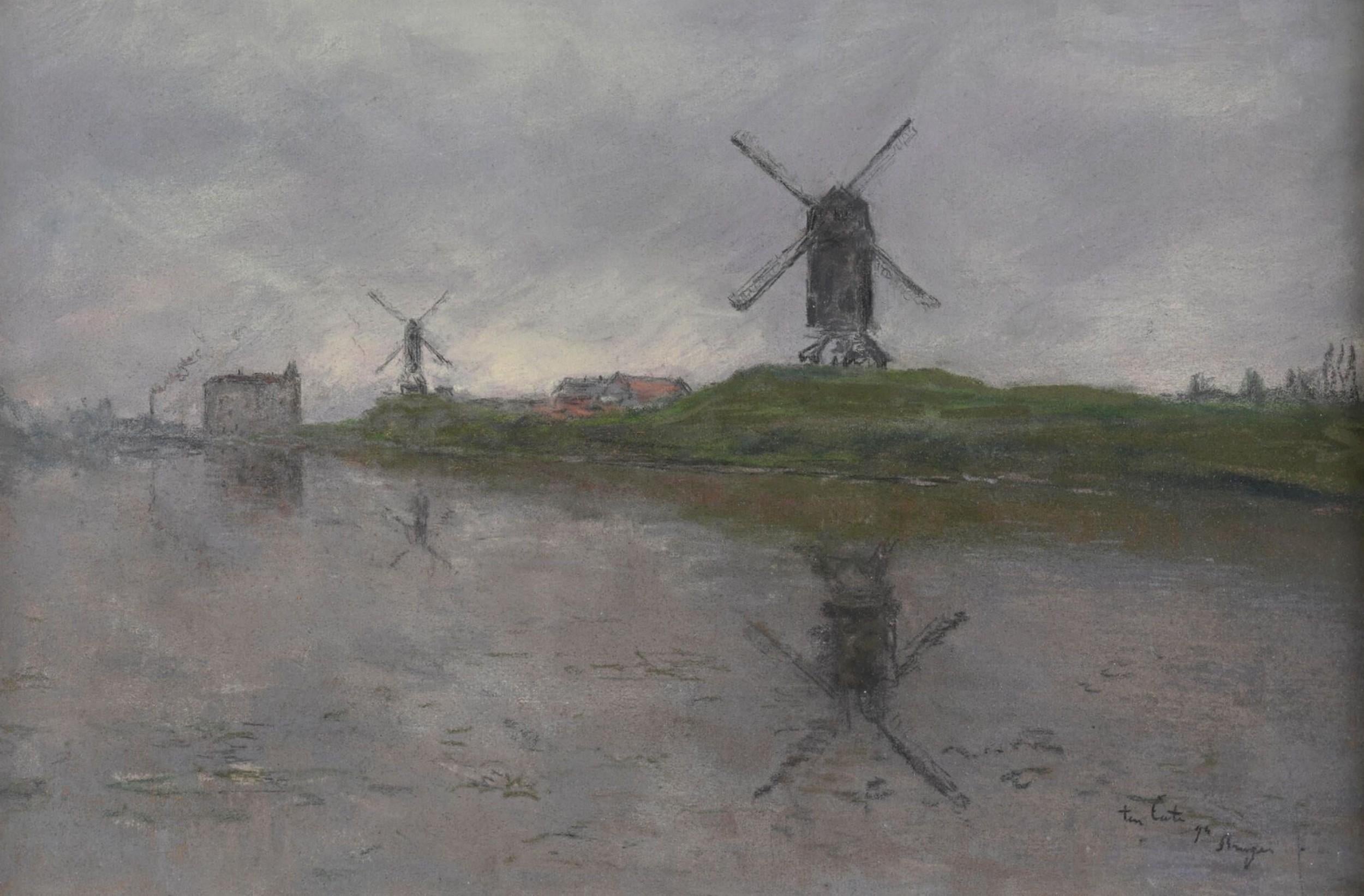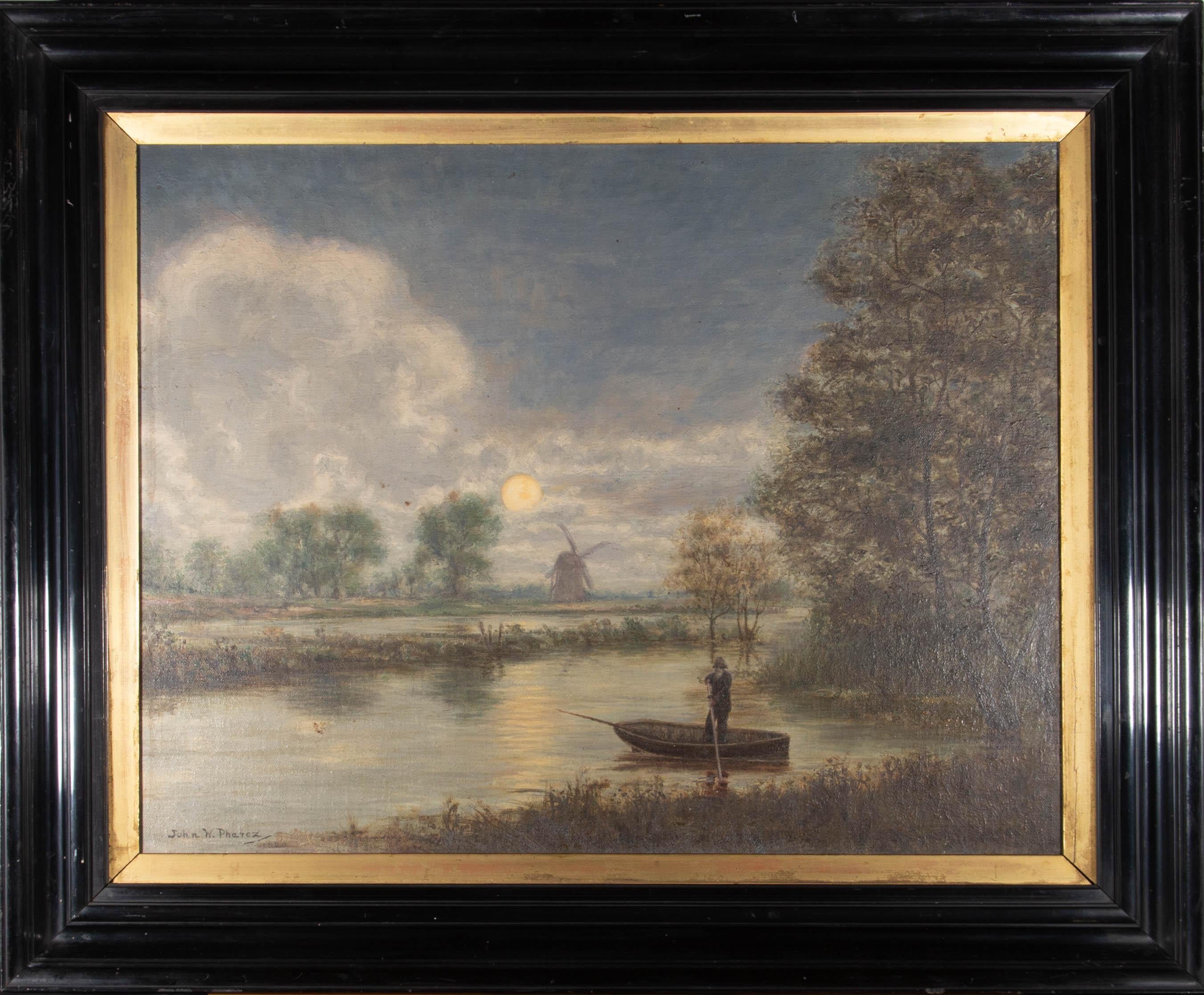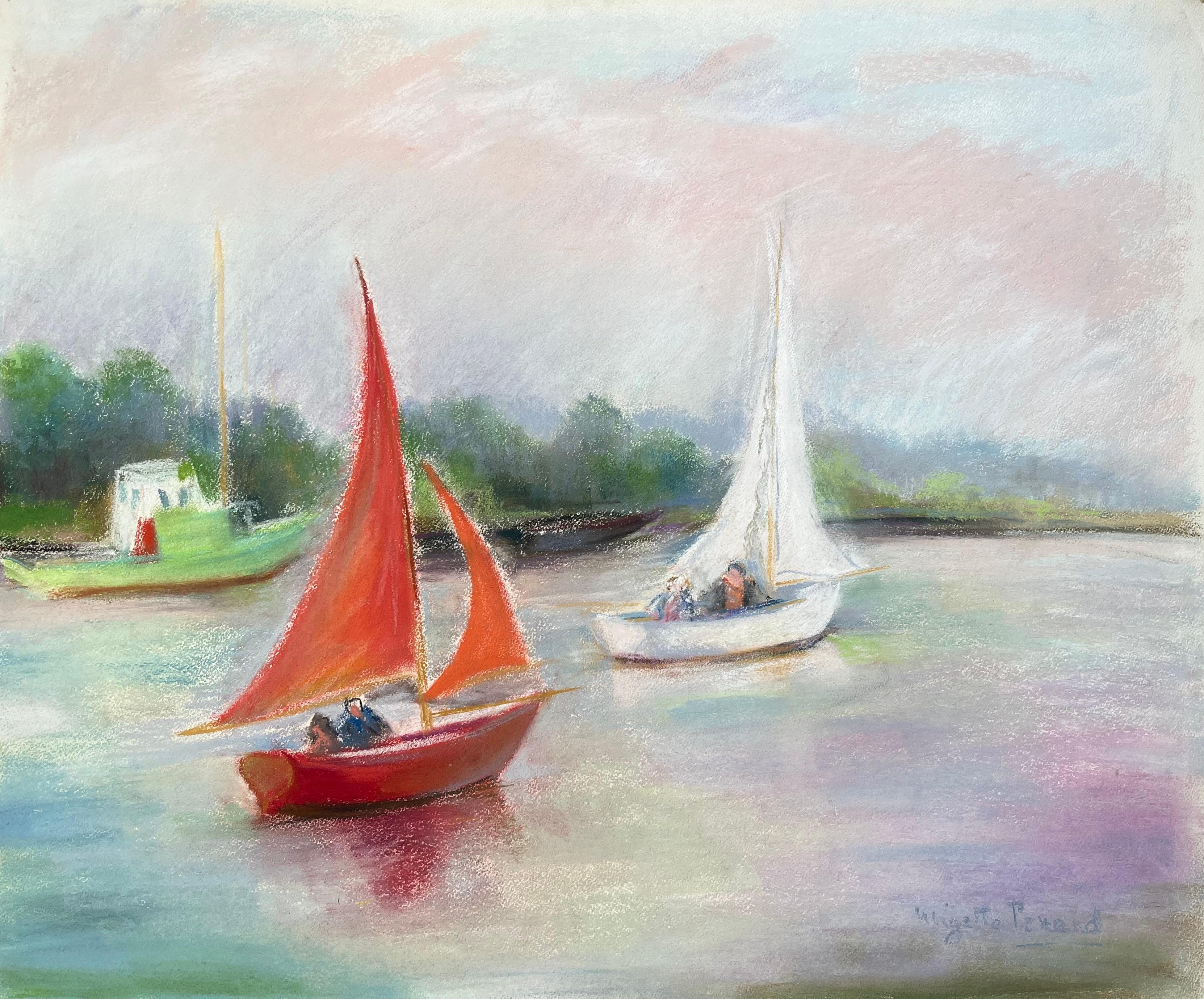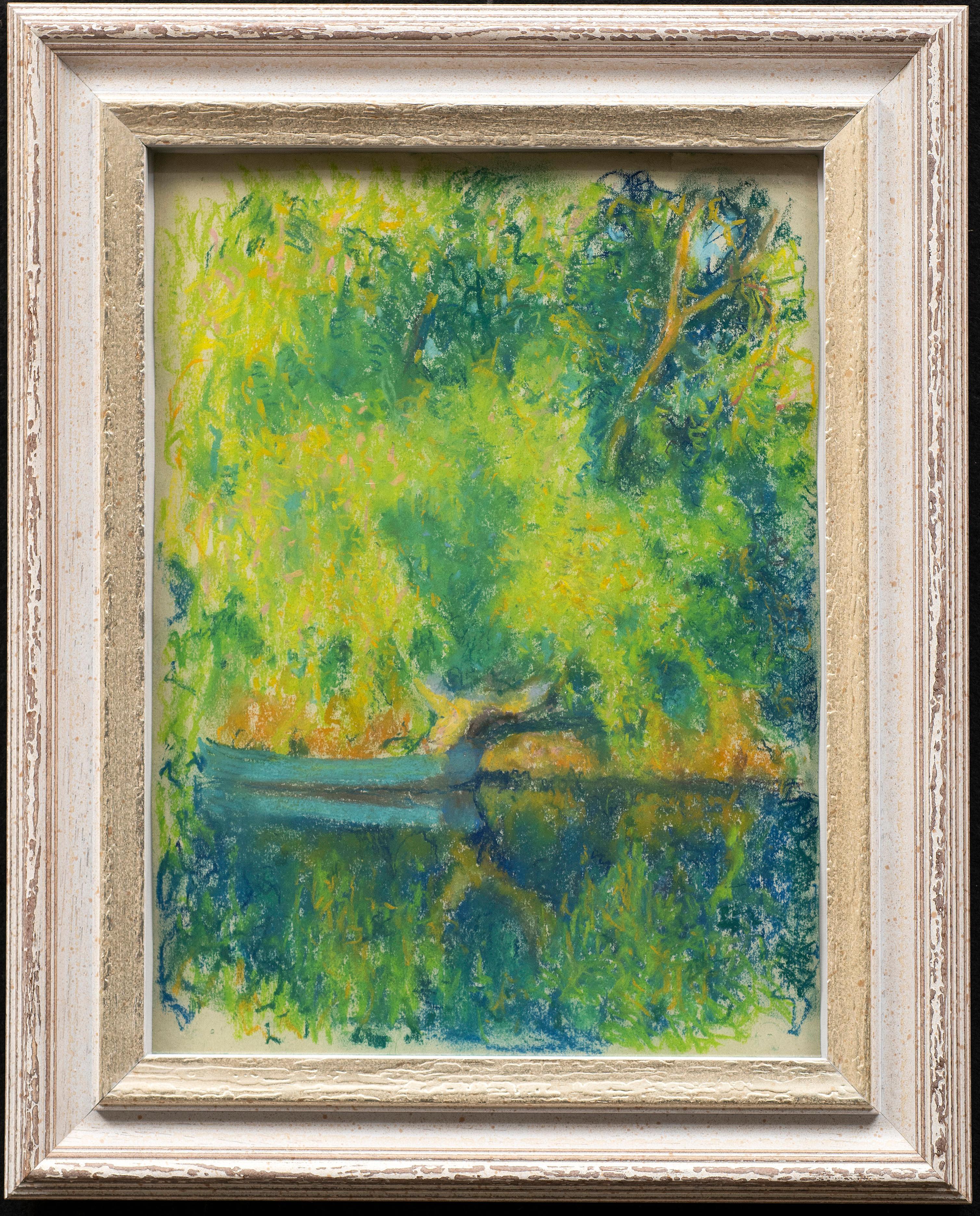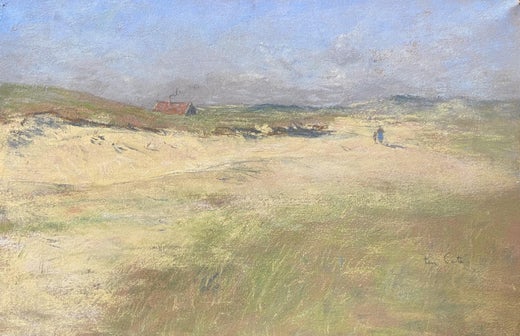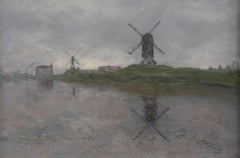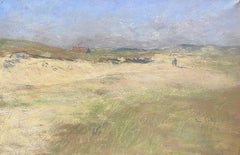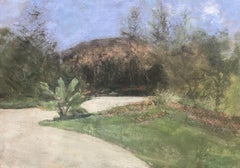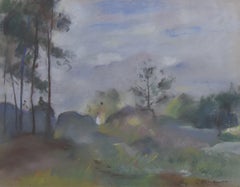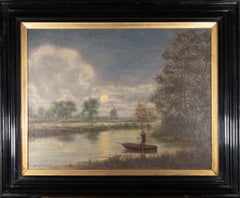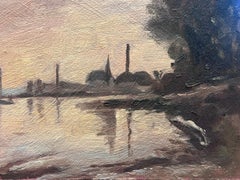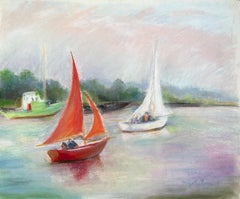Items Similar to Siebe Johannes Ten Cate (1858-1908) Mill and sailboat in the moonlight, pastel
Video Loading
Want more images or videos?
Request additional images or videos from the seller
1 of 17
Siebe Johannes Ten CateSiebe Johannes Ten Cate (1858-1908) Mill and sailboat in the moonlight, pastel
$1,745.38
$2,181.7220% Off
£1,306.46
£1,633.0720% Off
€1,480
€1,85020% Off
CA$2,402.13
CA$3,002.6720% Off
A$2,677.43
A$3,346.7920% Off
CHF 1,404.76
CHF 1,755.9420% Off
MX$32,695.78
MX$40,869.7220% Off
NOK 17,787.26
NOK 22,234.0720% Off
SEK 16,811.66
SEK 21,014.5820% Off
DKK 11,266.80
DKK 14,083.5020% Off
About the Item
Siebe Johannes ten Cate (1858-1908)
Mill and sailboat in the moonlight,
Signed lower rigt
Pastel on paper
40 x 31 cm
Framed under glass : 52 x 44 cm
This landscape shows the outskirts of the city of Dordrecht, famous for its windmills. Although Ten Cate lived in Paris during his artistic life and made his career there, it is clear that he retained an attachment to his native country. Throughout his career, he was particularly fond of depicting rivers and watercourses and the play of reflections they provide; the reflection of the moon in the water of the canal is a very fine example of his typical Impressionist pastel work.
"A realist, Ten Cate pays scrupulous attention to detail, to impressions, to the hustle and bustle of crowds and the solitude of deserted places. We have spoken of variations in tone linked to the time of day and the seasons. Rainy and snowy weather, water and ice are generally chosen by the painter, who uses pastels for this purpose."
Véronique Prest in "Catalogue des pastels du Musée Carnavalet"
Siebe Johannes Ten Cate was born in Sneek (Netherlands) on 27 February 1858. His father was mayor of the town
In 1876 Siebe decided to go to the Academy of Fine Arts in The Hague and, after graduating, continued his studies in Antwerp and Brussels. At the age of twenty-two, he settled in Paris and opened his own studio.
Soon, he found himself influenced by impressionism.
He made frequent trips for inspiration, visiting England, Scandinavia, Switzerland, North Africa and North America. However, his home remained 65 rue de Malte in Paris, where he lived with his cats and dog. Ten Cate led a secluded life and devoted himself to an impressive body of work in which landscapes and cityscapes are most often immersed in an atmosphere of rain and snow.
He exhibited frequently, notably at the Salon d'Automne, but his works were not as well appreciated in the Netherlands as in France so, although he made numerous visits, he never returned there.
The French press was unstinting in its praise for Ten Cate. He was called, for example, ‘the new Jongkind’. After his death, an English newspaper ran the headline ‘Sad End of a Genius’.
Museums and galleries in France began to take an interest in Siebe ten Cate's work in the 1890s.
The Louvre bought no fewer than four paintings from him, and the Musée Carnavalet even bought a good twenty. Art dealers such as Durand-Ruel and Ambroise Vollard exhibited ten Cate in their galleries alongside famous Impressionists.As a result, Ten Cate became friends with Alfred Sisley, Camille Pissaro and Vincent van Gogh. Van Gogh described Ten Cate as "a very neat man, completely dressed in black cloth".
His paintings and pastels were exhibited at the Salon d'Automne alongside those of Jean-Baptiste Corot.
His favorite subjects were landscapes, city and harbor views, often populated with figures. Le Havre was one of his favorite locations. He also made some etchings and lithographs.
He died on a Paris street from a sudden attack of "congestion". Later, there would be unsubstantiated rumors that he died of starvation, or was shot by a rival artist. For many years, his work was neglected in the Netherlands. A major retrospective was held at the Fries Scheepvaart Museum in 2012.
Unjustly forgotten for a time, he has fortunately regained the favour of art lovers, who now see him in his rightful place. His artworks are in different museums : Amsterdam (Rijksmuseum), Paris (Musée Carnavalet, Musée d'Orsay, Fondation Custodia) and Geneva (Petit Palais), Cleveland (Cleveland Museum of Art)
- Creator:Siebe Johannes Ten Cate (1858 - 1908, Dutch)
- Dimensions:Height: 15.75 in (40 cm)Width: 12.21 in (31 cm)
- Medium:
- Movement & Style:
- Period:
- Condition:
- Gallery Location:Paris, FR
- Reference Number:Seller: inv 4391stDibs: LU1112215475812
Siebe Johannes Ten Cate
Siebe Johannes Ten Cate was born in Sneek (Netherlands) on 27 February 1858. His father was mayor of the town In 1876 Siebe decided to go to the Academy of Fine Arts in The Hague and, after graduating, continued his studies in Antwerp and Brussels. At the age of twenty-two, he settled in Paris and opened his own studio.
Soon, he found himself influenced by impressionism. He made frequent trips for inspiration, visiting England, Scandinavia, Switzerland, North Africa and North America. However, his home remained 65 rue de Malte in Paris, where he lived with his cats and dog. Ten Cate led a secluded life and devoted himself to an impressive body of work in which landscapes and cityscapes are most often immersed in an atmosphere of rain and snow.
He exhibited frequently, notably at the Salon d'Automne, but his works were not as well appreciated in the Netherlands as in France so, although he made numerous visits, he never returned there.
The French press was unstinting in its praise for ten Cate. He was called, for example, ‘the new Jongkind’. After his death, an English newspaper ran the headline ‘Sad End of a Genius’.
Museums and galleries in France began to take an interest in Siebe ten Cate's work in the 1890s.
The Louvre bought no fewer than four paintings from him, and the Musée Carnavalet even bought a good twenty. Art dealers such as Durand-Ruel and Ambroise Vollard exhibited ten Cate in their galleries alongside famous Impressionists.As a result, ten Cate became friends with Alfred Sisley, Camille Pissaro and Vincent van Gogh. Van Gogh described Ten Cate as "a very neat man, completely dressed in black cloth". His paintings and pastels were exhibited at the Salon d'Automne alongside those of Jean-Baptiste Corot.
His favorite subjects were landscapes, city and harbor views, often populated with figures. Le Havre was one of his favorite locations. He also made some etchings and lithographs.
He died on a Paris street from a sudden attack of "congestion". Later, there would be unsubstantiated rumors that he died of starvation, or was shot by a rival artist. For many years, his work was neglected in the Netherlands. A major retrospective was held at the Fries Scheepvaart Museum in 2012.
Unjustly forgotten for a time, he has fortunately regained the favour of art lovers, who now see him in his rightful place. His artworks are in different museums : Amsterdam (Rijksmuseum), Paris (Musée Carnavalet, Musée d'Orsay, Fondation Custodia) and Geneva (Petit Palais), Cleveland (Cleveland Museum of Art)
About the Seller
5.0
Gold Seller
Premium sellers maintaining a 4.3+ rating and 24-hour response times
Established in 2018
1stDibs seller since 2019
249 sales on 1stDibs
Typical response time: 2 hours
- ShippingRetrieving quote...Shipping from: Paris, France
- Return Policy
Authenticity Guarantee
In the unlikely event there’s an issue with an item’s authenticity, contact us within 1 year for a full refund. DetailsMoney-Back Guarantee
If your item is not as described, is damaged in transit, or does not arrive, contact us within 7 days for a full refund. Details24-Hour Cancellation
You have a 24-hour grace period in which to reconsider your purchase, with no questions asked.Vetted Professional Sellers
Our world-class sellers must adhere to strict standards for service and quality, maintaining the integrity of our listings.Price-Match Guarantee
If you find that a seller listed the same item for a lower price elsewhere, we’ll match it.Trusted Global Delivery
Our best-in-class carrier network provides specialized shipping options worldwide, including custom delivery.More From This Seller
View AllSiebe Johannes Ten Cate (1858-1908) Bruges, windmill canal, 1894, pastel signed
By Siebe Johannes Ten Cate
Located in Paris, FR
Siebe Johannes Ten Cate (1858-1908)
Bruges, windmill canal, 1894,
Signed, located and dated 94 lower right
Pastel on paper
27 x 41 cm
in good condition, very fresh,
Framed under g...
Category
1890s Impressionist Landscape Drawings and Watercolors
Materials
Pastel
Siebe Johannes Ten Cate (1858-1908) A Dune Landscape, pastel signed
By Siebe Johannes Ten Cate
Located in Paris, FR
Siebe Johannes ten Cate (1858-1908)
A Dune Landscape
Signed lower right
Pastel on paper
25.5 x 39.5 cm
in good condition, very fresh, traces of pinholes in the upper corners barely...
Category
1890s Impressionist Landscape Drawings and Watercolors
Materials
Pastel
$1,745 Sale Price
20% Off
Siebe Johannes Ten Cate (1858-1908) A garden in Zurich, 1898, pastel signed
By Siebe Johannes Ten Cate
Located in Paris, FR
Siebe Johannes Ten Cate (1858-1908)
A Garden in Zurich, 1898
Signed, located and dated "Zurich 98" lower right
Pastel on paper
28.5 x 41.5 cm
in good condition, trace of a small t...
Category
1890s Impressionist Landscape Drawings and Watercolors
Materials
Pastel
Henry Ottmann (1877-1927) A forest in the mist, pastel signed
By Henri Ottmann
Located in Paris, FR
Henry Ottmann (1877-1927)
"Orée du bois par brume", A forest in the mist
signed lower right
pastel on paper
24 x 32 cm
In good condition
In a vintage frame : 43.5 x 53 cm The gilding on the frame is missing in many places
Henry Ottmann particularly excelled in the pastel technique, as can be seen here.
This is due to the fact that this delicate material obviously lends itself very well to the artist's characteristic vaporous style and manner.
We should also note the great modernity of this landscape and its fades, which go almost as far as abstraction.
Henry Ottmann was born on 10 April 1877 in Ancenis.
He made his debut at the Salon La Libre Esthétique in Brussels in 1904 and took part in the Salon des Indépendants in Paris from 1905, the Salon d'Automne, the Salon de la Société Nationale des Beaux-Arts and the Salon des Tuileries.
In 1911 and 1912, Ottmann exhibited at the Artistes de la Société Moderne at the Gallery Paul Durand-Ruel together with Armand Guillaumin, Henri Lebasque and others. In 1912, he exhibited at the gallery Eugène Druet.
In 1920, Ottmann exhibited at the gallery Marcel...
Category
1910s Post-Impressionist Figurative Drawings and Watercolors
Materials
Pastel
$548 Sale Price
25% Off
The Mills in Montmartre, Paris, 1907, oil on panel signed and dated
Located in Paris, FR
The Mills in Montmartre, Paris, 1907
Oil on wood panel
signed (illegible) and dated "07" on the lower left
18 x 20 cm
in good condition : a small inpainting visible on the left borde...
Category
Early 1900s Impressionist Landscape Paintings
Materials
Oil
$1,132 Sale Price
20% Off
Paul Lecomte (1842-1920) L'étang à Mortefontaine, signed watercolor
By Paul Lecomte
Located in Paris, FR
Paul Lecomte (1842-1920)
L'étang à Mortefontaine, an autumn landscape
signed lower left
Watercolor on paper,
29,3 x 22.5 cm
In its original vintage frame : 46 x 39,5 cm
titled on t...
Category
1880s Impressionist Landscape Drawings and Watercolors
Materials
Watercolor
You May Also Like
Dutch riverlandscape with windmill, impressionist, oil on panel, double signed
By Edward Antoon Portielje
Located in DEVENTER, NL
Edward Antoon Portielje (1861 - 1949), C.H. Hermans, possibly his second wife Rosa Hermans
Dutch riverlandscape with windmill
Signed upperleft corner 'Edward Portielje' and lowerright corner C.H. Hermans 1880
Oil on panel
Dimensions excl. frame: 17 x 26 cm.
Dimensions incl. frame: 34 x 43 cm.
Edward Antoon Portielje (8 February 1861, Antwerp – 18 December 1949, Antwerp) was a Belgian genre painter.
He was born to the painter Jan Portielje and his wife Eulalie (née Lemaire, 1828–1903). His older brother, Gerard, was also a genre painter.
His first art lessons came from his father. Then he attended the Royal Atheneum and, from 1873, took after-school classes at the Royal Academy of Fine Arts with Edward Dujardin. From 1877 to 1881, he was a full-time student at the Academy under the tutelage of Polydore Beaufaux, Charles Verlat and Nicaise de Keyser...
Category
Late 19th Century Impressionist Landscape Paintings
Materials
Oil, Wood Panel
John W. Pharez - 1920 Oil, Moonlit River Scene
Located in Corsham, GB
A tranquil scene depicting a man rowing across a moonlit river. In the distance a windmill can be seen on an open field. The artist has used a slight impasto effect on the trees and ...
Category
20th Century Landscape Paintings
Materials
Oil
$517 Sale Price
20% Off
Dusktime Twilight River Scene Sailing Boat on Water Large Skyline
Located in Cirencester, Gloucestershire
River Landscape
by Geza Somerset-Paddon (British 20th century)
oil painting on board, unframed
size: 7 x 10 inches
condition: overall very good
inscribed verso
provenance: all the pa...
Category
20th Century Impressionist Landscape Paintings
Materials
Oil
Mid-20th Century Post-Impressionist Pastel of Sailboats on a Calm River
Located in Cirencester, Gloucestershire
Title: Mid-20th Century Post-Impressionist Pastel of Sailboats on a Calm River
by Anne Marie Migette Perard (French 1902-1977)
Signed: Yes
Medium: Pastel on unframed paper
Size: 18.2...
Category
Mid-20th Century Post-Impressionist Landscape Paintings
Materials
Pastel
"Barque sur la Seine (Boat on the Seine)" Pastel, Raymond Thibesart (1874-1968)
By Raymond Thibesart
Located in SANTA FE, NM
"Barque sur la Seine (Boat on the Seine)"
Raymond Thibesart (France, 1874-1968)
Circa 1920s
Pastel on Paper
Studio stamp and INV Nbr. 1710RT
12.6 x 9.5 (16 3/4 x 13 3/4 frame) inches...
Category
Early 20th Century Post-Impressionist Landscape Paintings
Materials
Pastel
"Soir de Novembre, Dordrecht, " Eugene Vail, Dutch Landscape with Boats, Cloudy
By Eugène Lawrence Vail
Located in New York, NY
Eugène Laurent Vail (1857 - 1934)
Soir de Novembre, Dordrecht
Oil on canvas
19 1/4 x 25 3/4 inches
Signed lower left; titled in two places on the stretcher with various other inscriptions, stamped "MADAME G:VAIL A" and inscribed "177" in ink and "#43" in pencil on a partial label from Garde-Meuble Maple affixed to the stretcher
Eugene Vail (Saint-Servan, France September 29, 1857 - Paris, December 28, 1934), the son of a French mother and an American father, Lawrence Eugene Vail, studied at the Stevens Institute of Technology in Hoboken, New Jersey (where Alfred Stieglitz was born in 1864) and graduated with a degree in mechanical engineering in 1877. Then he became a student of William Merritt Chase and J. Carroll Beckwith at the Art Students League before returning to France. He entered the Ecole des Beaux-Arts in 1882 where he was instructed by Alexandre Cabanel, Raphaël Collin, and Dagnan-Bouveret (1852-1929), known as an extreme naturalist. When Bastien-Lepage died in 1884, Dagnan-Bouveret became the leader of the Naturalist School. He definitely made an indelible impression on Vail.
According to Louise Cann, Vail soon became an independent painter working at Pont-Aven and Concarneau. It is difficult to determine when he separated from his teachers since he is listed as a student whenever he exhibited at the Paris Salon — that is, until 1899 when he dropped the mention of élève. A picture of a peasant girl, Seulette was his Salon debut painting in 1883, the same year that he sent two scenes of Brittany to the Pennsylvania Academy of the Fine Arts' exhibition, which documents his stay in that region.
The next year he exhibited in the Salon: Fishing Port, Concarneau, which went to the Luxembourg Museum (it is now in the Musée Municipal of Brest). It has the Naturalist brown and gray palette and tonalist atmosphere but already shows that Vail had direct experience with scenes of life in coastal villages: "So convincing was his familiarity with the French coast that the critic Thiébault-Sisson claimed him as a Frenchman and declared that no American marine painter could touch his skill." (Maureen C. O'Brien, in Blaugrund, 1989, p. 218).
In 1885, Vail exhibited Inner Port at Dieppe and in the following year On the Thames (Private collection), which later won him the Grand Diploma of Honor from an international jury in Berlin in 1891. Widow, the title of Vail's entry in the Salon of 1887 (unlocated), is a striking image of a woman standing on a beach, looking out to the expanse of the ocean where her husband obviously met his end. The innocent child who looks at us may have the same fate in store for him. Then in 1888, Vail completed his masterpiece, Ready, About! a "wall-size" 94 x 125½ inch canvas. The painting won a first-class gold medal in the Salon of 1888, then at the Paris Universal Exposition of 1889, Vail won another gold medal.
The first precedent that comes to mind is Théodore Géricault's colossal Raft of the Medusa of 1819 (Louvre), the celebrated romantic image of castaways about to be rescued after being lost at sea. But while Géricault presents a massive, sculpturesque group of figures struggling on a raft just beyond our designated viewing space, Vail pulls the viewer into the picture, or more exactly, extends the diagonally rocking boat into the spectator's area, vividly anticipating the effects of cinematography. There is no more effective way to engage the spectator's attention and sympathies, and the illusionism is especially effective in this life-size picture.
Vail's vigorous brushwork — a uniform use of rectangular strokes — adds to the motion-filled, dynamic actuality of this image, and the overall green-gray tonalities evoke the constantly menacing, cold and wet travails in the life of the fishermen in the Atlantic's rough waters. Theodore Child (1889, p. 518) wrote about this painting: "very beautiful in color, and amongst the very strongest and best pictures of this kind in the Exhibition."
Dordrecht (unlocated) was Vail's painting exhibited at the Pennsylvania Academy in 1892, and in the following year he showed Fisherman — The North Sea at the Paris Salon, the same year in which he re-exhibited Dordrecht and On the Thames at the World's Columbian Exposition in Chicago. Vail won the coveted Légion d'Honneur in 1894. Some of his paintings found their way to European museums, for example, Soir de novembre (Odessa Museum) and Soir de Bretagne (Museo d'Arte Moderna, Venice). The latter was exhibited at the Exposition Universelle of 1900 in Paris. Also there was Voix de la mer (Voices of the Sea), which we identify as the painting that appears in an interior view of the American section, just to the right of a doorway (fig. 20 in Fischer, 1999), a simple marine painting.
Some time after 1900, Vail turned to both impressionism and post-impressionism but no one seems to have charted this course. His Autumn near Beauvais, illustrated in International Studio (1902, p. 211), The Flags, St. Mark's Venice (1903; National Gallery of Art), and Grand Canal, Venice, ca. 1904 (Museum of Art, Rhode Island School of Design) demonstrate an impressionist technique with broken color. Mandel (1977, p. 202) wrote on the latter: "applied in short strokes juxtaposing brilliant hues of orange, blue, white, black and red, with a strong interplay between the warm pink tones of the walls and the green shadows of the black boats which are silhouetted against them." Cann (1937) believed that in Venice, Vail "found his true self." The Flags forecasts the Armistice Day pictures by Hassam and others, painted fifteen years later.
Vail became involved in the Society of American Artists in Paris and the Société Internationale de Peinture et de Sculpture, whose membership included Frank Brangwyn, Charles Cottet (1863-1924), the famous Naturalist sculptor Constantin Meunier (1831-1905), Frits Thaulow...
Category
Early 20th Century American Impressionist Landscape Paintings
Materials
Canvas, Oil
More Ways To Browse
Antique French Press
Van Gogh Drawings
Water Mill
Watercolors North Africa
French Sailboats Art
Paris In The Rain
Water Mill Painting
River Of No Return
Rainy City
Cat Pastel Paintings
Shot Glass French
Moonlight Impressionist
Corot Etching
Amsterdam Cityscape Paintings
Antique Shot Glass Shot Glasses
Antique Shot Glasses Shot Glasses
Antique Shot Glasses
Lithograph Four Seasons
